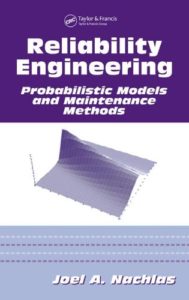Reliability Engineering: Probabilistic Models and Maintenance Methods
Reliability Engineering: Probabilistic Models and Maintenance Methods
Reliability Engineering: Probabilistic Models and Maintenance Methods is intended to support either an introductory course in reliability theory and preventive maintenance planning or a sequence of courses that address these topics. Fairly comprehensive coverage of the basic models and of various methods of analysis is provided. An understanding of the topics discussed should permit the reader to comprehend the literature describing new and advanced models and methods.
Presenting an integrated approach to reliability evaluation and maintenance planning, Reliability Engineering: Probabilistic Models and Maintenance Methods provides comprehensive coverage of the fundamental concepts of reliability theory, basic models, and various methods of analysis. It contains numerous examples and homework problems in each chapter. The first six chapters sequentially outline each basic concept of reliability theory, followed by two chapters on commonly used statistical methods for evaluating component reliability.
you can also read Maintenance, replacement, and reliability : theory and applications
Reliability Engineering: Probabilistic Models and Maintenance Methods
- Introduction
![Reliability Engineering: Probabilistic Models and Maintenance Methods]()
- System Structures
- Reliability of System Structures
- Reliability over Time
- Failure Processes
- Age Acceleration
- Nonparametric Statistical Methods
- Parametric Statistical Methods
- Repairable Systems I — Renewal and Instantaneous Repair
- Repairable Systems II — Non-renewal and Instantaneous Repair
- Availability Analysis
- Preventive Maintenance
- Predictive Maintenance
- Special Topics
- A:Numerical Approximations
- B:Numerical Evaluation of Weibull Renewal Functions
- C:Laplace Transform for the Key Renewal Theorem
- Bibliography
- Index
Without proper reliability and maintenance planning, even the most efficient and seemingly cost-effective designs can incur enormous expenses due to repeated or catastrophic failure and subsequent search for the cause. Today’s engineering students face increasing pressure from employers, customers, and regulators to produce cost-efficient designs that are less prone to failure and that are safe and easy to use. An understanding of reliability principles and maintenance planning can help accomplish these conflicting goals.


Comments are closed.